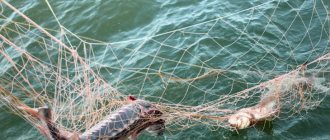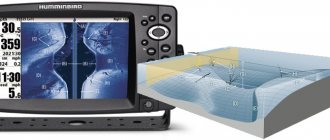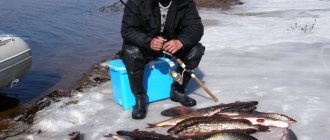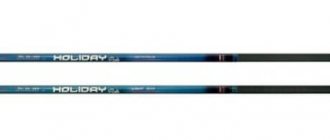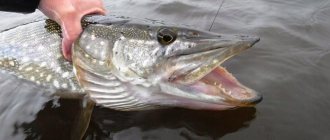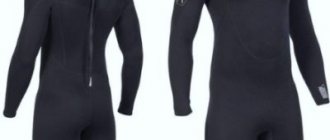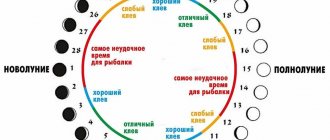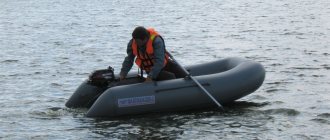- Fishing
13043
Each body of water has a certain amount of fish, which is constantly changing under the influence of various factors. Conventionally, they can be divided into two categories: natural (natural) and artificial. The first group includes the characteristics of a particular reservoir, food supply, the presence of predators and... perhaps that’s all. There are many more artificial factors, from pollution to fishing pressure. All this, of course, causes harm to the underwater population, but not as great as poaching and fishing with nets.
It happens that you throw a lure and catch a fishing net, and in it there are several living individuals and dozens of dead ones. Such fishing gear is not of great value, especially Chinese products. You can buy them for pennies. That's why poachers never take them off. And sometimes they even forget where they put it. This Chinese net stands in the water and catches big and small fish. It catches for years until it rots in the water along with the caught fish.
Today, on fishing websites and elsewhere, you can find articles written in defense of net fishing. If you wish, you can even find detailed instructions on how to install nets correctly, in what places, and how to disguise them so that no one sees. The authors of such publications (most likely they are poachers themselves) try to justify the destruction of fish stocks using prohibited methods. They say that this is not poaching and there is nothing wrong with catching a few heads in a net. This is not an electric fishing rod, it does not kill young animals.
They also hide behind the rural population living on the banks of large rivers. They write that people in villages are forced to fish in nets to feed their families. Does one family really need 10-15 kg of fish every day? Hardly. A person who has lived most of his life near a large waterway could have long ago learned to provide himself and his loved ones with fish, having only a couple of fishing rods in his arsenal.
Box fishing net.
This fishing net is shaped like a box (sometimes several boxes in a row).
It is usually used with a feeder.
Installed on the bottom of the reservoir.
Afraid of strong currents.
Effective for catching bottom fish.
These networks are further divided into several types:
- knotless,
- nodal,
- knotless with retention,
- nodal with retention.
Nodeless networks.
Nodeless networks are those networks in which the forming cell has no nodes.
Such a network allows cells to become smaller or larger.
Basically, this is a big plus, since when catching small fish, it can escape into a large, extended cell.
The downside of such a net is that after fishing you need to sort through the net and arrange the cells according to size.
Nodal networks.
The first time you use a knotted fishing net, you will feel a big difference compared to a knotless net.
Such a network has a cell fixed on all sides by nodes.
The knots prevent the cell from deforming and it is much easier to operate.
But there is also a minus - this is the size of the network cell.
For each type of fish, you need to select a specific net with a mesh size.
Another disadvantage is that the fish gets entangled in it a little worse, since the cell is not deformed.
Knotless fishing nets with retention.
Similar to the principle of nodeless networks, these networks have a sliding cell.
An addition to a nodeless network is one end of the network assembled into a node.
In my practice, I came across one of these.
After fishing, it was necessary not only to disassemble the net, but also to lay it out correctly for the next use.
I didn’t like fishing with her, although it can be noted that the catch was simply enormous.
I have no idea what caused the big catch.
Knotted fishing nets with retention.
These networks are popularly called a casting network.
It can be cast both from the shore and from a boat.
Very common among fishermen with different experience.
It has a central part with a rope and a bypass leash for closing the net.
I can’t point out any particular shortcomings. The only thing is probably the small area of water coverage.
You will feel the advantages yourself when you fish with it.
RusCamping - exchange of experiences and opinions
“The Way of the Samurai (Hagakure)” or how to learn to fish with a casting net.
The casting net, or as it is called in Russia, the casting net, is without a doubt one of the most impressive fishing gears.
The fisherman makes a swing and a fantastic circle suddenly unfolds in the air from a shapeless skein of ropes and threads, beautifully covering the surface of the water... and within a minute a rich catch falls at the fisherman’s feet. And aesthetically pleasing, beautiful and rewarding! Isn't it an ideal fishing tool? Having come across videos on fishing with a cap net on the Internet (you will find links to watch and download them in the notes to this article), you will probably think that this is the happiness of a fisherman. One throw - a bucket of fish. But the realities are such that, as a rule, everything will not be so smooth and, as they say: the “net” will often come not with fish, but with “grass of the sea”... But we will strive for perfection and in this series of articles there will be just and it is described what and how to do so as to never leave the reservoir without rich spoils.
Legal aspects of net fishing.
For those who believe that casting net fishing, or as it is called throughout the world, is poaching (and in most CIS regions, by law, it is so), I will immediately say that we will not discuss this here (although your opinions are in the comments will be useful). I will only say that in many regions such fishing is allowed, but is limited to a net size of up to 2 meters, similar to the one for the little fish. In addition, if you treat casting net fishing as a sport, and elite sports, as you know, are not cheap hobbies, then we can assume that for the sake of your hobby you are ready to pay the local fish inspectorate for a license for net fishing, so Moreover, you don’t need a large fishing quota. Reasoning on this matter can be read here (how not to poach with a net) and here (about fishing with casting and hatching, is it a sport or poaching), but let’s return specifically to fishing with a kasitna net as a subject.
Types of casting networks. Theory.
Having decided to engage in this type of fishing or, if you will, sport, you will need to decide for yourself which type of casting nets will be more convenient for your soul to use. The most common types are Spanish and American. Of course, they can then be combined and even usefully used under different fishing conditions.
The American casting network is a dome, the bottom of which is planted with a loaded cord, from which, along the entire perimeter from the inside to the top of the cone, ropes tied at certain distances go up, they are called slings. At the top of the cone, the slings are brought together into a single hole (ring), in such a way that when the net is pulled up behind them, the slings wrap its lower edge inward, forming a kind of bag around its entire circumference. It is most catchy when fishing from a boat or bridge - where its final rise occurs vertically.
For example, this net manufactured by the Japanese company Momoi Fishing is shown in Figure 1.
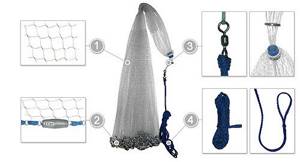
Fig.1
- network fabric;
- cargo;
- ring and carabiner;
- throw cord.
The Spanish casting net forms the same bags (in it they are called pockets), but not with the help of the edges of the net drawn inward with slings, as in the “American” one, but has them right by design. Pockets are initially tied during manufacturing and attached with special threads to the main mesh fabric along the entire perimeter (see Fig. 2). This type of net is usually used when fishing by wading, from the shore or at very shallow depths.
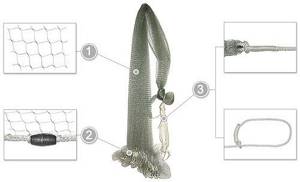
Fig.2.
- Network fabric;
- Loaded cord;
- A throw cord tied to the top of the net cone with a hand loop.
There are also African and other types of nets, which are essentially the same 2 main types listed above, but slightly modified to suit fishing conditions. It is worth noting that on the Internet and among fishermen this net can be heard by different names - it’s a parachute, a cape, a seine, a cast net (from the English Cast Netting) and just a cast net or a cast net - all this is about fishing with a casting net .
As already mentioned, in order to start using a casting net, you need to learn how to throw it, but despite all the apparent simplicity, in fact, throwing a casting net is not so simple.
The Japanese consider casting the net an art . In this country, the act of laying a net and throwing it has been elevated to the rank of a ritual. Such competitions in Japan are called Oka-ami, and the technique of casting the Tosa-ryu casting net is considered no less prestigious than the technique of wielding the Japanese sword - the katana.
Should I buy a casting net or tie/make it myself?
This is a question for an amateur and whether the item is handmade or not, as well as a matter of time... Of course, making a network “for yourself” is cool, but connecting a good network and equipping it correctly is a whole science. If this is your path, then on this site there are several articles on how to make a casting network yourself. I eventually came to the truth that it is better to buy a casig network and only then, as a last resort, if something fails to complete it for you. Now a huge selection of castine networks is offered by Chinese aliexpress, I take it here - https://ali.pub/59s0fe.
Casting net throwing training.
There are dozens of throwing methods and over time you will choose the one that suits you best. Nets that are small in diameter can simply be thrown by holding the top edge, but nets over 1.5 meters must be specially folded and thrown according to the rules. There are even special devices - rings with which you can cast medium-sized nets without mastering any techniques at all (see links in the comments to this article), but this is not our method because the aesthetics of casting disappears, and you also have to carry it with you the ring is too much, not samurai style ;).
Therefore, I strongly recommend mastering the classic Japanese method of casting a casting net - see the video for details. Without hiding, everything is shown and shown several times - a practical lesson in casting a net.
Having mastered assembling the net and casting by throwing the edge of the net over your shoulder (in Japanese), try to pick up the net higher with this technique of throwing from bushes or an unstable boat, you will be able to throw the net in any conditions without the risk of catching something (with a high pick-up).
I strongly recommend making marks on the net with a marker in the places where you will take, intercept, and hold the net. - this way you will always have a perfect assembly. In addition, when training, it will be easier for you to see by the marks which part of your network is not deployed or is confused. To adjust the net set and throw.
Promotion . A very important point. A poorly promoted network will not lie in the right circle. Try to swing the net and launch it along as flat a trajectory as possible, slightly upward. The swing must be done from behind the back with the body rotated almost 180 degrees.
An important point for opening the net is to hold its edge at the moment of throwing. The easiest way to deal with this problem, described in many ways, is to take the cord between your teeth when assembling the network. When thrown, it will be “pulled” out of your mouth last, thereby ensuring that the edge of the net is pulled back. But I would not advise you to learn and get used to this method of throwing, since it is only acceptable for sports throwing on land or for fishing in the sea. In other cases, already on the second throw you will have to put a cord stained with silt and mud into your mouth, which is not very hygienic. Therefore, I advise you to immediately choose a method of casting without using your mouth as an aid in casting.
In particular, the purely Japanese style (cast net japanese style) is very good in this regard, where the net is thrown over the elbow, and to tighten the edge, the cord is taken between the little finger and the ring finger of the hand. Although this method is much more difficult to master, once you master it you will be able to throw nets of almost any diameter. A detailed video of this throw can be seen below. By the way, human thought does not stand still, and now fishermen have come up with all sorts of devices to make it easier to throw a casting net.
went hunting...
Don’t be lazy to clear the net of grass and branches after casting, even if you are in the heat of the excitement of fishing. And ALWAYS unravel the bottom cord if it gets tangled. It is not without reason that another name for the casting net is “parachute” and I think it comes not only from the appearance of the net as a dome descending to the bottom of the river, but also from the importance and responsibility of folding it before throwing it, like a parachute before a jump. It’s better to spend a couple of extra minutes preparing the fishing gear for throwing than to be upset by an unsuccessfully thrown net that didn’t unfold properly, which, in addition, needlessly frightened all the potential prey.
And now the network is abandoned. Depending on its load, find out how many seconds it will take it to reach the bottom, after which you can start retrieving it. At depth, this moment is visible by the way the cord leaving behind the sinking net suddenly stops. Next, as in any fishing, you should make a hook. The hook is made not too sharply, but with a confident jerk, which allows the casting net to create a protruding and retracted pocket on an American-type net or to straighten out the pockets on a Spanish one. During this pull, you should not lift the net too high from the bottom, since it has not yet brought all the loads to the center, closing the exit for the fish...
Next, the net is slowly pulled towards the fisherman... And as soon as its beginning appears out of the water, you should use your hand to help it close completely when pulled out into the air.
Read the continuation of the article here.
Well, this is what typical casting net fishing looks like in central Russia (and actually in Ukraine, Belarus and Kazakhstan ;)) - a short documentary on casting fishing:
Good luck with your fishing!
Stock fishing net.
stock fishing net
This net is usually used to catch crustaceans.
It has one entrance in the form of a valve that prevents exit.
It can also catch bottom fish.
Used with a feeder or groundbait.
It is installed both on the bottom of the reservoir and on the surface of the reservoir, on floats.
Looking at the shape of this net, you can immediately guess that the hole for the fish to enter is of a certain diameter.
If you have a diameter of about 30-40 cm in the running tube, then you can’t count on big fish.
However, this form of fishing net is quite reliable in fishing.
Setting up networks
In order to set nets from a boat, a certain skill and at least minimal experience are required. It's easiest to do this together, but it's quite possible to do it alone. But you can use the net without having a boat.
The grid can be installed:
- from a boat;
- wade;
- from the shore;
- under the ice (in winter).
Using a boat, you can place nets in the most interesting places in terms of catch. You can’t do without it on large rivers and lakes.
It should be noted that successful fishing is only possible if the angler knows the reservoir well and the migration routes and stopovers of the fish.
If the fishing net is used in a small body of water, then setting can be done by wading. This method is good in shallow places, and makes it possible to set up various corridors from the nets to catch wary fish, such as salmon.
From the shore it is possible to set it using the so-called drag method; it is performed by two fishermen. The net is “pulled” into the water using a cord with a load, which is thrown to the opposite shore, where a smooth cord from the net is tied to it.
In winter, nets are set by drilling a series of holes through which the net is pulled using a pole with a hook. The method is quite labor-intensive, but if there is a current in the reservoir, tedious drilling of ice can be avoided. The performance is done using a large float, which is set adrift with a flowing cord attached. For such an operation it is enough to drill only one hole.
Cone fishing nets.
Cone nets
At first glance they look like a casting network, but there is a small difference.
Cone nets are shaped like a cone (see picture), while casting nets are shaped like a circle.
When such a net is lowered, with weights along the edges, it clearly falls along a directed route like a parachute.
Also, this network can be installed in winter through a hole.
when prepared, it has a relatively small volume.
The downside is the fact that when the net is lifted, the fish can escape.
Closing the network must be done very smoothly.
Dive fishing nets. In other words - a net, a landing net.
Fishing net, landing net
You will laugh, but they also belong to fishing nets.
Sometimes you don’t need a fishing rod or other nets to catch fish with these particular nets.
An extremely indispensable thing when pulling out large fish.
Some fishermen use a fishing net or landing net to store fish near the shore.
If we do not consider the humorous attitude towards fishing nets, then this is an indispensable thing for fishing.
If you fish with a rod, without using nets, then a fishing net or landing net will definitely come in handy.
Winter fishing with nets
Supporters of amateur and sport fishing methods have an extremely negative attitude towards netting poachers, but in winter, on certain bodies of water, the use of nets can be not only justified, but also completely legal. In the northern regions of the country, fishing with nets is a tradition that allows you to provide fish for yourself and others.
If the net as a fishing tackle were outlawed, then it is unlikely that we would have the opportunity to buy carp, bream, pike and other tasty representatives of the underwater world in supermarkets. However, one must remember that such fishing is legal only in some regions and only with the permission of the relevant authorities.
Fishing with nets in winter is a complex, labor-intensive activity that requires the participation of a whole group of people in the process. The thicker the ice and the longer the tackle, the more hands will be required to install it. How this happens in practice will be discussed below.
In what places can networks be installed?
It’s worth saying right away that only large bodies of water are suitable for fishing with nets: large deep lakes, deep rivers. Of course, you can put the gear on a pond if there is at least a couple of meters deep there, but in such “puddles” the fish do not grow to an acceptable size, so there is nothing special to catch there.
Since in cold weather underwater inhabitants prefer to stay in the deepest parts of the reservoir, it is advisable to place the net closer to its center. It is important that the bottom in this place is as smooth and clean as possible, without stones, snags, submerged trees and watercraft. Otherwise, snags and breaks of the mesh fabric cannot be avoided.
Preparatory work
When the fishing zone and the direction of installation are determined, you can begin preparation, namely, removing snowdrifts from the ice and creating ice holes. First, two large lanes are made at a distance from one another equal to the length of the network.
- These are the outermost holes of a rectangular shape, the approximate size of which is 0.5 x 1 m. Their lower inner edges are beveled at a certain angle so that the tackle cord slides easily and does not cling to icy corners. Then smaller holes are cut down between them in a straight line at intervals of 3-4 meters.
- At this stage, tools such as an ice pick, an ice pick, and a chainsaw are used.
Standard installation
Directly to install the gear you will need other devices:
- a run is a strong and even pole, the length of which sometimes reaches 10 meters;
- racing - a special rope for stretching a net under the ice;
- sewed - a wooden pole with a small hook at the end for adjusting the purlin and fabric.
The process itself looks something like this. A race is pulled through the upper part of the net, the end of which is tied to the run, after which the latter is wound into one of the outer holes.
If fishing is carried out on a river, then it should be an ice hole located upstream. The lower part of the network is necessarily loaded. Thanks to the weights, the canvas will stretch to its full height and will not get tangled.
Then the pole with the net is carefully pushed under the ice to the second hole, there it is corrected with a sewer and sent to the third.
When the run reaches the outermost large ice hole, it is removed from the water, the race is untied and with its help the rest of the net is pulled under the ice.
To prevent it from sagging, it is fixed in the intermediate holes - tied to sticks. In this case, the edge of the tackle must be below the ice, otherwise it may freeze.
That, in fact, is all the work, now all that remains is to wait for the unsuspecting fish to be trapped.
Installation with torpedo
This device replaces a wooden purlin. It is equipped with an electric motor, toothed disks, batteries and warning lights to indicate its location under the ice. It is driven by a cord.
- It is enough to pull it, and the torpedo with an attached rope will be directed in the given direction. When she swims a certain distance, she is stopped and an ice hole is cut, then another section is passed, and so on.
- Installing a network with a torpedo is much easier and faster.
Fishing with a scarf
This network is a type of the well-known screen and differs from it only in the shape of the canvas. The scarf is triangular, which allows it to be used in winter.
- A springy metal wire is tied to the base of the triangle, which can be folded in the middle and inserted into the hole. It also performs the function of loading.
- Having passed through a narrow hole, the rod straightens and the scarf takes on its working position.
- The technique of catching fish with a scarf is simple. First you need to drill a hole, throw some food into it (store-bought or prepared yourself) and lower the tackle on a rope to the very bottom.
- Let us remind you: in winter, fish stay at depth, because it is warmer there than at the surface. The second end of the rope is tied to a stick, which will lie across the hole and hold the entire structure.
As a rule, anglers install many scarves at night and check them in the morning.
Conclusion
Some consider netting to be blatant poaching and condemn the people involved in it. Yes, there are plenty of poachers who do not have permits for such fishing, but everyone else is caught legally. Therefore, you should not blame them. Especially those who know nothing about the harsh life in the North.
Source: https://FishingsBlog.ru/lovlya-zimoj-setyami.html
Flag fishing nets. Types of fishing nets.
From the name it is already clear that such networks have the shape of a flag (canvas).
These are ordinary fishing nets.
It’s another matter if the canvas is not one layer but several.
I witnessed when fishermen arranged 4 layers of flag nets together.
When I asked why they do this, I received this answer:
The fish are different and then it’s easier to sort them out
